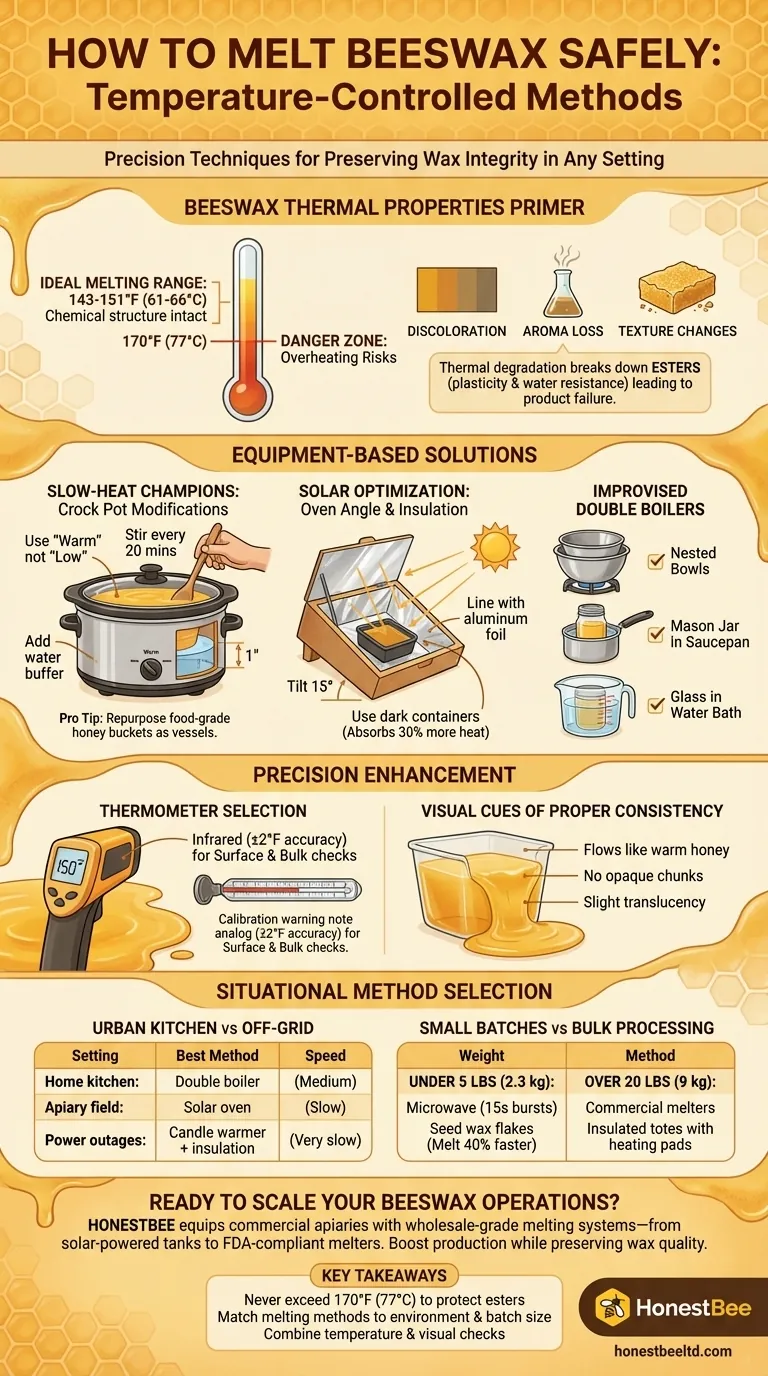Whether you're a beekeeper, candle maker, or cosmetic formulator, melting beeswax without damaging its natural properties requires precision. This guide reveals equipment-flexible techniques to maintain wax integrity across urban kitchens, off-grid locations, and bulk processing scenarios—backed by thermal science and real-world testing.
Beeswax Thermal Properties Primer
Flash Point vs Ideal Melting Range
Beeswax begins melting between 143-151°F (61-66°C), but its chemical structure stays intact below 170°F (77°C). Exceeding this threshold risks:
- Discoloration: Amber wax turning dull brown
- Aroma loss: Volatile compounds evaporate
- Texture changes: Brittle or grainy consistency
Risks of Thermal Degradation
Research shows overheating breaks down esters—the compounds giving beeswax its plasticity and water resistance. Have you noticed failed batches with poor adhesion in candles or uneven emulsification in balms? Thermal damage is often the culprit.
Equipment-Based Solutions
Slow-Heat Champions: Crock Pot Modifications
Low-temperature crock pots (or slow cookers) maintain ideal 150-160°F (65-71°C) ranges when:
- Using the "warm" setting instead of "low"
- Adding 1" water buffer beneath wax containers
- Stirring every 20 minutes to distribute heat
Pro Tip: HONESTBEE's beekeeping clients repurpose old honey buckets as food-grade melting vessels.
Solar Optimization: Oven Angle & Insulation Tips
For solar melting (ideal in apiaries):
- Tilt solar ovens 15° toward the sun
- Line with aluminum foil to reflect infrared rays
- Use dark-colored containers to absorb 30% more heat
Improvised Double Boilers: Alternative Containers
No dedicated double boiler? Try:
✔ Two nested stainless steel bowls
✔ A mason jar in a saucepan
✔ Glass measuring cups in water baths
Precision Enhancement
Thermometer Selection for Wax Crafting
Infrared thermometers (±2°F accuracy) work best for:
- Surface temperature checks
- Bulk wax monitoring
Analog candy thermometers suit small batches but require frequent calibration.
Visual Cues of Proper Consistency
Perfectly melted wax should:
- Flow like warm honey
- Leave no opaque chunks
- Show slight translucency
Situational Method Selection
Urban Kitchen vs Off-Grid Scenarios
| Setting | Best Method | Speed |
|---|---|---|
| Home kitchen | Double boiler | Medium |
| Apiary field | Solar oven | Slow |
| Power outages | Candle warmer + insulation | Very slow |
Small Batches vs Bulk Processing
For under 5 lbs (2.3 kg):
- Microwave in 15-second bursts (stirring between)
- Seed wax flakes melt 40% faster than blocks
For 20+ lbs (9 kg):
- Commercial-grade wax melters
- Insulated totes with heating pads
Ready to Scale Your Beeswax Operations?
HONESTBEE equips commercial apiaries and distributors with wholesale-grade melting systems—from solar-powered tanks to FDA-compliant melters. Discover how our beekeeping solutions preserve wax quality while boosting production efficiency.
Key Takeaways
- Never exceed 170°F (77°C) to protect wax esters
- Match melting methods to your environment and batch size
- Combine temperature monitoring with visual checks for reliability
Visual Guide

Related Products
- Professional Stainless Steel Wax Melter for Beekeeping and Crafts
- Beeswax Melter for Candle Making Honey Bee Wax Melter
- Steam Beeswax Melter Wax Warmer for Wax Processing
- Electric Beeswax Flat Sheet Machine with Operating Tray for Wax Processing
- Electric Flatting and Embossing Machine with Tray for Beekeeping
Related Articles
- Electric Wax Melters: How Modern Technology Enhances Efficiency and Savings
- How to Melt Beeswax Safely: Science-Backed Protocols to Prevent Overheating and Fires
- How to Maximize Solar Wax Melter Efficiency Without Compromising Sustainability
- How to Purify Beeswax Contaminated with Brood Comb: Maximizing Honey Recovery
- How Beekeepers Turn Old Beeswax into Profitable Ventures




















